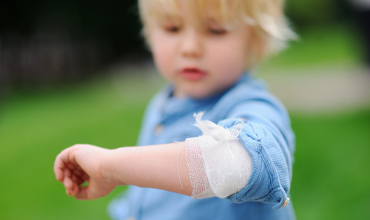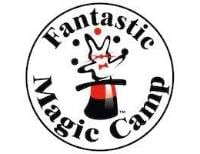You can model what to do in an emergency by remaining calm and talking your child through minor injuries. For other emergencies like fire safety and broken bones, you can use role-playing to help kids understand what to do. Set a date on your calendar at least once a year to review first aid, fire safety and what to do in an emergency. This will help your child remember what she learned and remain calm if she is faced with one of these situations.
For bumps and bruises
For a typical bruise, explain that when you bump into something it causes bleeding under the skin. Apply an ice pack to the bruise to prevent swelling and reduce pain. Show your child where you store ice packs and how to wrap one in a paper towel so the ice isn’t directly on the skin.
Call 911 for help if…
your child has a head injury and is acting strangely or if she is experiencing nausea, vomiting, confusion or vision changes.
For cuts
If your child has a cut, teach her to use a clean cloth to put pressure on it to slow bleeding. When the bleeding has stopped, clean the wound and apply antibiotic ointment and a bandage.
Call 911 for help if…
the cut is deep, will not stop bleeding, has something stuck in it or you can see ligaments or bone.
For sprains and broken bones
Any time there is a suspected broken bone, your child should ask for help from an adult. Teach her not to touch the injured area and apply ice while waiting for help.
Call 911 for help if…
the bone is bent or sticking out or if she cannot move or put weight on the injured area.
For burns
If your child has a mild burn, run it under cool tap water for 15 minutes and repeat as needed. Do not apply ice directly to the wound. If the burn blisters, ask your child to leave it alone as much as possible as this will help with the healing process.
Call 911 for help if…
the injury is making it unable to move or if the injury is waxy looking or bigger than the palm of your hand.
For bug bites and stings
If your child has a bug bite, wash the area and apply ice for swelling and pain. You can also apply calamine lotion to help with itching.
Call 911 for help if…
your child has an allergic reaction to an insect sting or bite.
For choking
If someone is choking, remain calm and ask the person questions. If she can answer, then she is still able to breathe. If she is coughing, wait and see if she can clear the airway on her own. An older child can be taught how to do stomach thrusts (formerly known as the Heimlich maneuver) to help dislodge the item that is choking her. An older child can also be taught how to perform stomach thrusts on others.
Call 911 for help if…
someone is struggling to breathe and is not able to cough or speak.
When to Call 911
Once your child can read numbers, teach her how to use a phone to dial 911 for emergencies. Create a list of people to call in an emergency including 911 and family and friends who would be willing to help if needed. Write your home address on the paper as well so kids can refer to it if needed. Try role-playing with your child so she knows what to expect. Here are some quick Do’s and Don’ts to help you know when to call 911:
DO call 911
- If there is a fire
- If someone is struggling to breathe
- If someone is unconscious
- If someone is choking (cannot
talk and is not coughing) - If there is a car accident
- If there is a crime
DON’T call 911
- If there is not an emergency
- If your pet is sick
- For a prank
- For minor injuries
Sarah Lyons is a mom of six kids, including 9-year-old triplets. She enjoys reading, writing and spending time outdoors with her family.

















